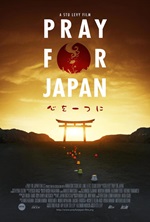The Japanese tsunami of 2011 was a disaster of such epic proportions that the footage looks like something out of an overblown Hollywood blockbuster. The initial earthquake shut down the country's infrastructure almost immediately: no electricity, no Internet, no cell phones.

Then the ocean wave hit, washing away entire neighborhoods—along with everything and everyone in them. A mass of houses float away, like some misshapen barge. In the days that followed, gasoline became scarce. Food was severely rationed; at one shelter, a thousand people survived for three days on just four bottles of water. And then there was the Fukushima nuclear near-crisis. In the end, 20,000 were dead or missing, and there was $325 billion in damage.
Details like these help make the first thirty minutes of Pray for Japan compelling, leaving viewers with nothing to say but simply, "Oh my God." The documentary releases to limited theaters for just one day—Wednesday, March 14, the one-year anniversary of the disaster—as a fundraiser, with all money going straight to relief efforts in Japan.
Pray for Japan recaps the fateful details with amazing footage and interviews. (The film is largely in Japanese with English subtitles.) The tsunami is only a prologue, however, with the film predominantly focused on what happened in the following weeks as people fought to survive and somehow return to a sense of normalcy.
But Pray for Japan starts to falter for its remaining hour, its scope too limited for a tragedy so big. Some might argue that narrowing things helps scale down the nation's tragedy to a more personal level, but there are too many topics left untouched. There's no mention of the Fukushima crisis, no stories related to the Japanese government, and no reports of the impact on Japanese industry.
The film focuses on the portside city of Ishinomaki in the northeast, and specifically reduces the tragedy to four topics. After a middle school locates its student body (all miraculously accounted for), the faculty searches for a place to continue the children's studies and community. Meanwhile, an 18-year-old learns that most of his family didn't survive, and resolves to honor his five-year-old brother's death while bringing his community together. A shelter led by a local councilman and assisted by Pakistani volunteers strives to maintain order and civility among its survivors. And in the least focused subplot, domestic and international volunteers assist the community.
Like many documentaries, Pray for Japan settles into a rut, bouncing between the four threads every five minutes with short poetic interludes in between. These stories are good for ten minutes each, but are not enough to sustain a 97-minute film. There's no question that this film could have told many more stories to better hold the audience's attention.
It's interesting that it's not titled Remember Japan or Save Japan or something else entirely. There's no spiritual component to this film, aside from a celebratory funeral that is more cultural in tone than religious. But clearly, the film's content alone is a good reminder that we should indeed continue praying for Japan, and helping in any way possible.
Here's the trailer:

Support Our Work
Subscribe to CT for less than $4.25/month


















